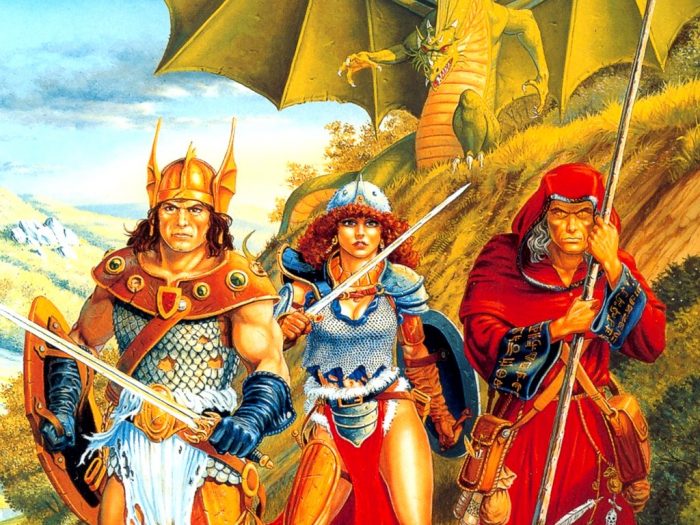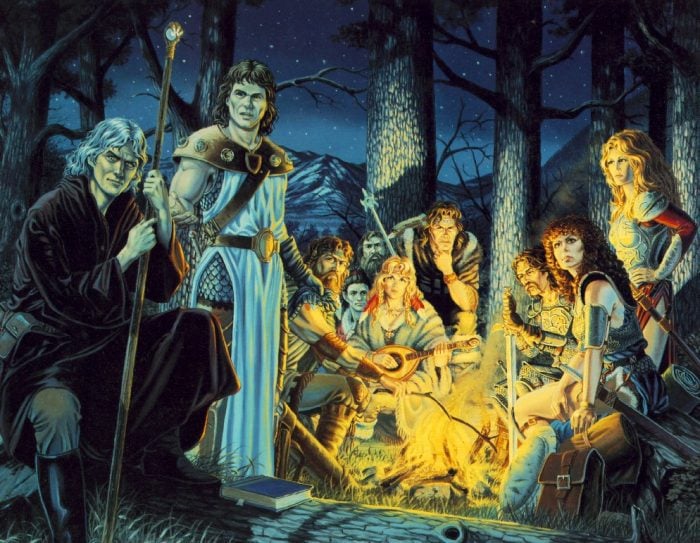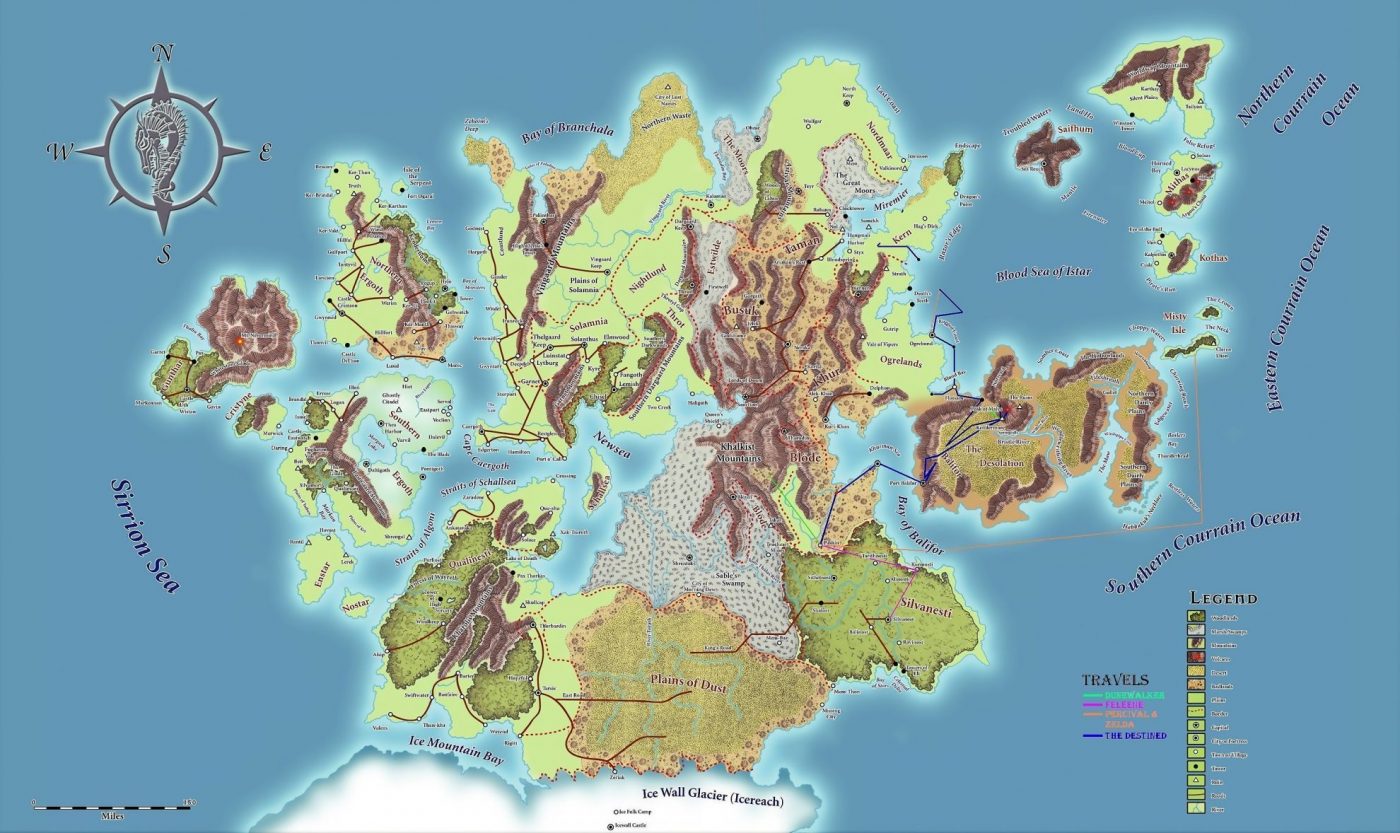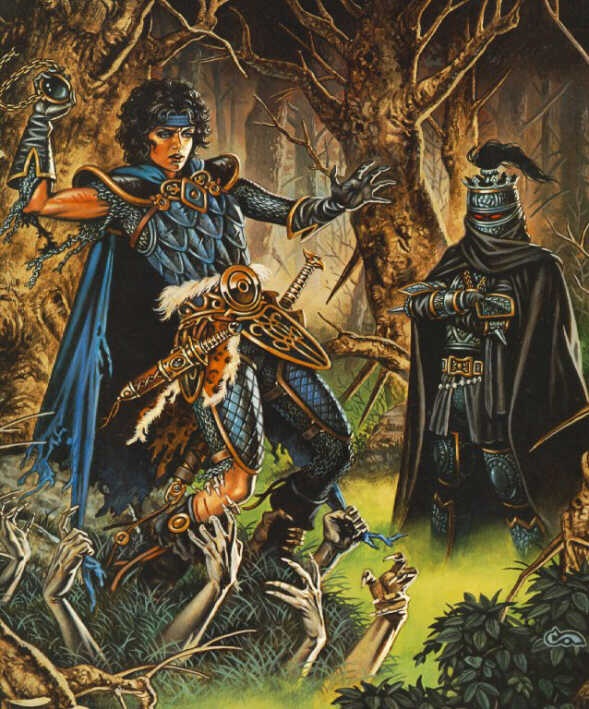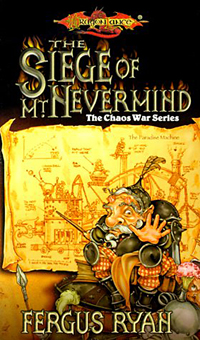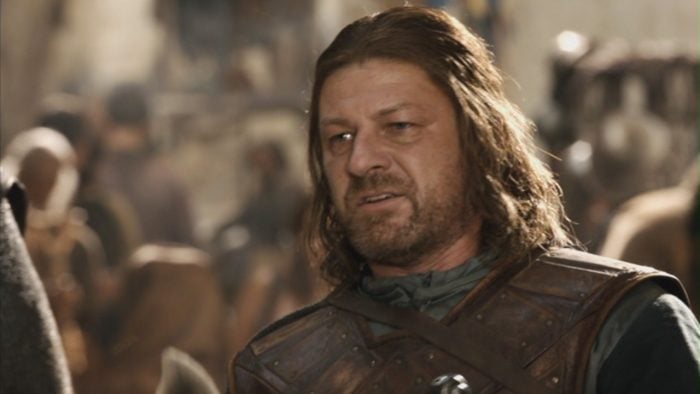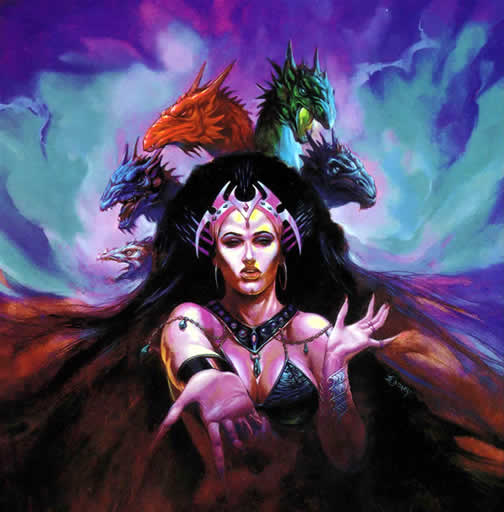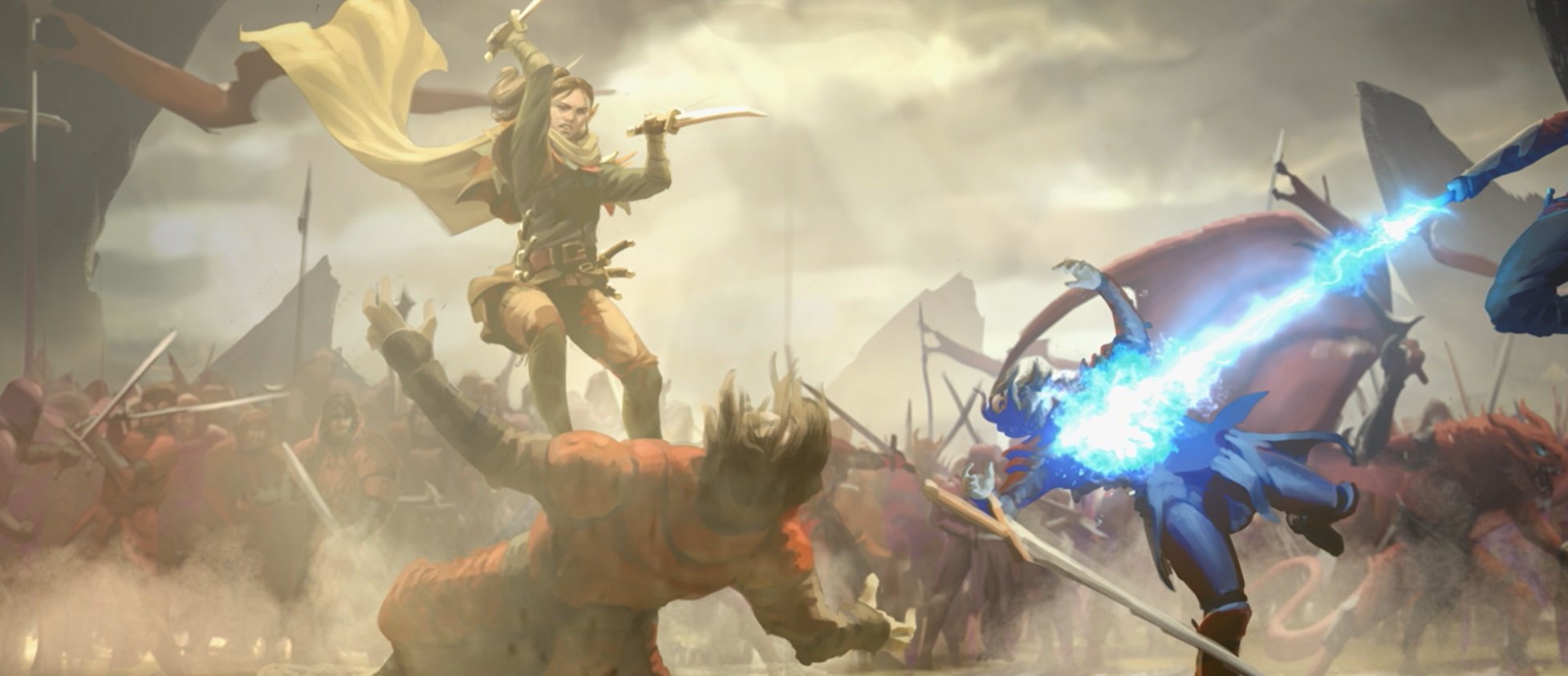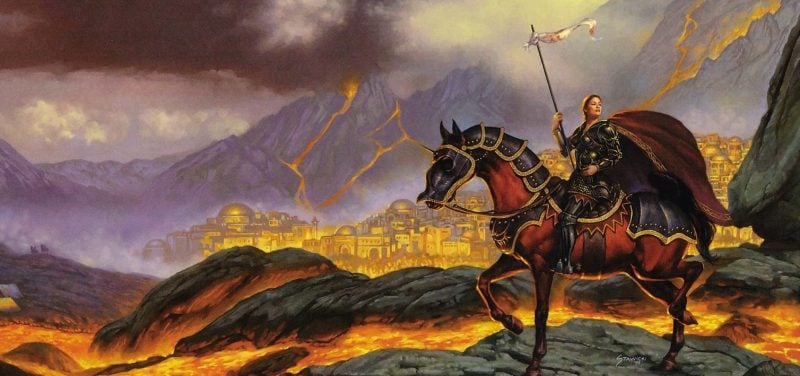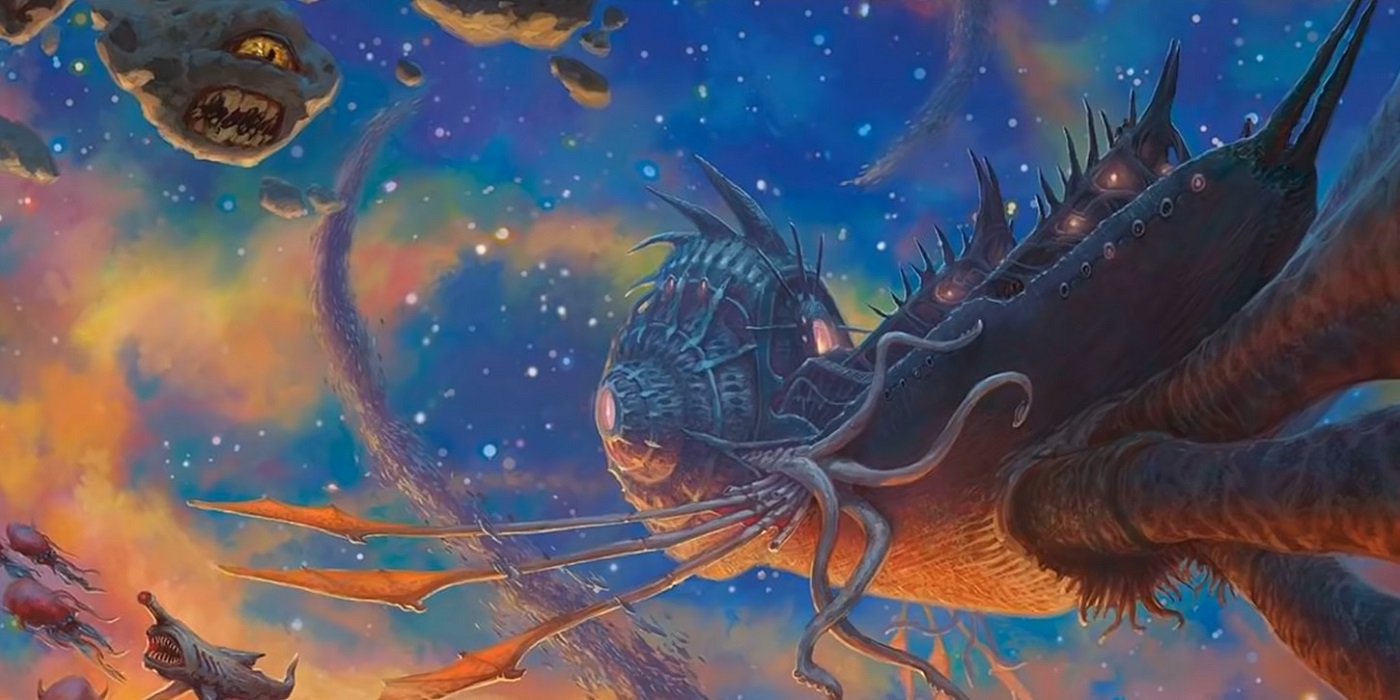D&D: Dragonlance Is in the Air, as Long as That Air Is on Krynn – An Adventurer’s Guide
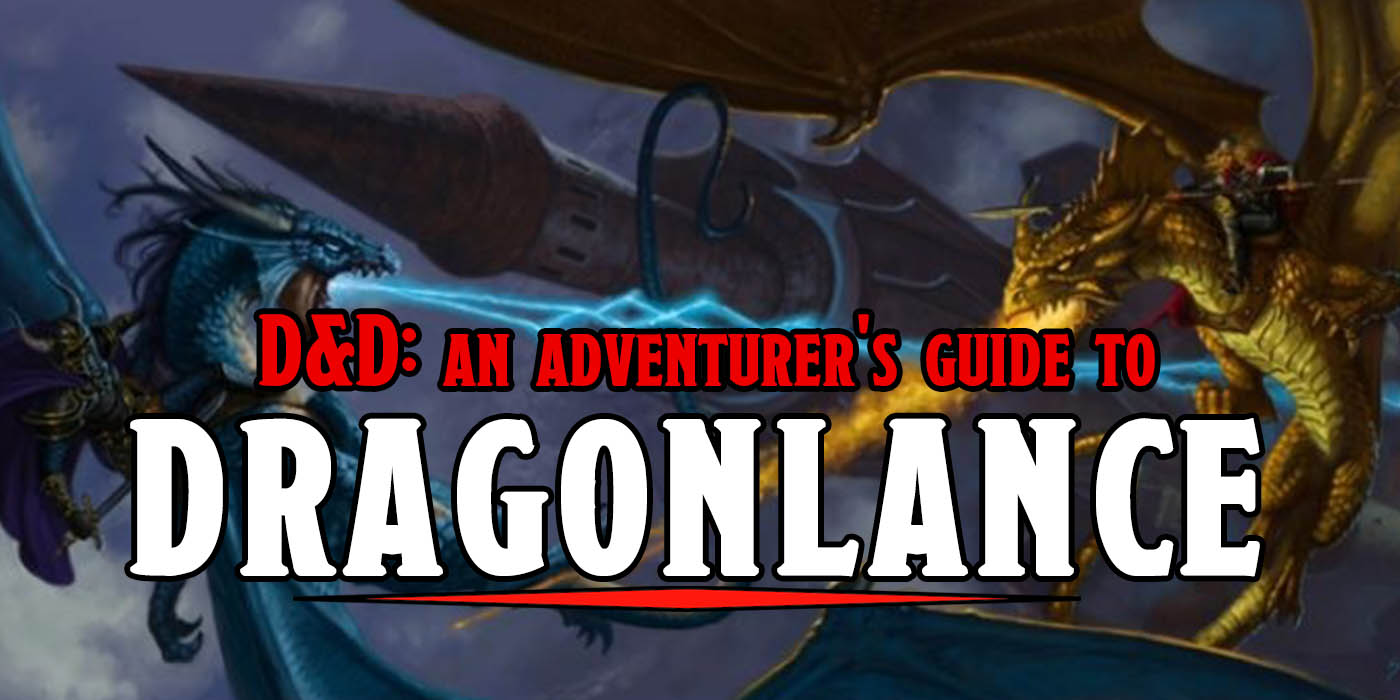

Dragonlance is back, baybee. A world beset by gods, dragons, and lances! Here’s your guide to the world of Krynn
Dragonlance is coming back at the end of the year. It’s getting a big adventure and a companion board/battle game. All of it wrapped up in the War of the Lance. What does any of that mean? We’re here to help you out. Let’s talk about Krynn.
Home to the Heroes of the Lance, Towers of High Sorcery (along with their color-coded robes and enough arbitrary magical rules that Harry Potter almost seems sensible. Almost.), gods who have turned their backs on the world, a wandering wizard named Gandal-uh…Elmin…nope – Fizban who is secretly the avatar of a god and he helps everyone out, and enough dragons to shake a lance at; Krynn is a world full of adventure. Krynn is the world of Dragonlance. And odds are good, even if you’ve never read any of the novels, or played in the campaign setting–your game has been affected by it. So let’s take a look at what makes Krynn tick.
I’m gonna say maybe a dragon, some kind of lance, smouldering glances, and not a trace of pants. Nobody’s wearing any in this picture. Nobody.
Dragonlance Chronicles
I think it’s safe to say that Krynn owes the shape of the world, and indeed its entire existence to The Dragonlance Chronicles, a series of novels written by Margaret Weis and Tracy Hickman at the behest of TSR. This was their first big push for there to be a story for Dungeons and Dragons–and if you read the novels, you’ll find a lot of D&D concepts lurking within the pages. Each of the main characters has a very distinct class, there’s an appearance of several magic items, including one of D&D’s most iconic artifacts, the Orbs of Dragonkind. In fact, they are a central plot device for a time.
The Dragonlance Chronicles center around a party of adventurers as they take part in the big world-shaking event de jour, the War of the Lance. As the backstory goes, the gods turned their back on the world because of one man’s hubris, even going so far as to throw down a mountain of fire upon the city that had torqued them off the most. A change which remains setting canon to this day.
From left to right: Broody Stu, C’mon Bro, No Really I’m a Half-Elf, David Hasslehoff, Cranky, Goldie Hawn, Kurt Russell, What Do You Mean I’m Being Played by Sean Bean, The Likable One, and Lorelai Gilmore
A cast of plucky heroes gets swept up from their humble meeting at an inn to take part in a series of adventures that build up to a massive war between good and evil – and if that’s starting to sound like a typical D&D campaign, that’s because these novels were shaped in part from an actual D&D campaign. That’s right, Weis and Hickman gathered up some of their friends and ran a campaign with the Heroes of the Lance as their player characters. So it just goes to show, you should take careful notes around your gaming table because you never know when your group is going to stumble into a bestselling adventure.
It worked too. These adventures spawned modules, more novels, a campaign setting, all manner of licensed products, including a board game and a series of miniature figures. Along with all the sweet Larry Elmore paintings you’ll find sprinkled throughout this article. The novels fleshed out the world enough that people were clamoring for more. They wanted to explore Krynn for themselves. So that’s what we’re going to do.
Geography of Krynn
Geographically speaking, Krynn is pretty interesting. It’s a big proponent of the rule of threes. There are three continents, three gods (with their companions, etc.) and three moons, representing one of three alignments: Solitari, Lunitari, and Nuitari, or Sun Moon, Moon Moon, and No Moon. One is evil, one is neutral, one is good. I bet you can figure it out.
DID SOMEONE SAY MOON MOON I’M HERE GUYS
Each of the moons has its own Order of Magic and its own tower of sorcery and the books explain all about that. Suffice it to say, they matter too. I am almost certain there’s a Spelljammer adventure that features a trip to one of the moons, and is awesome, but the majority of the action (and the details on the setting) takes place on the continent of Ansalon.
In the far north you’ll find steppelands, nomads, and horselords a-plenty. There are two big clans, the ones who roam the northern Wastes, and the nomads of Nordmaar, who pay homage only to the king of the north who rules from North Keep, where presumably they keep all the biographies of Oliver North. They like the north, is what I’m trying to say.
In the north is also where you’ll find Solamnia, a land of knights and tradition. Home to whatever kind of geographical feature you’d want – no less than three mountain ranges, the longest river, it’s near the coast – Solamina was left more or less untouched by the War of the Lance and the preceding cataclysm, right up until they weren’t. Kitiara Uth Matar, one of the main antagonists in the series (spoilers, I guess, but this came out in ’84, so you’re on your own), leads an army on the country, accompanied by none other than Lord Soth, whom you might recognize as the Death Knight.
I wasn’t joking when I said this world has affected your games. The appearance of Lord Soth defined death knights in D&D. That’s why it’s his face in the monster manual. So popular was he, that he made the leap to Ravenloft, where you may have encountered him. Or been killed by him. Same difference, really.
Moving on.
The Middle is a jumble of terrain features and sadness. There are impassable mountains, a giant swamp, treacherous seas. Basically if you want to make things rough for your players, have them cross the middle part of Ansalon and you’ll have no shortage of encounter types to draw from. Whether it’s horrible swamp monsters, sea monsters, or Mount Nevermind, which is home to the gnomes (it’s in the middle west, arguably) and sends Adam Harry into a frothing rage every time it’s brought up.
The lower section of Ansalom is much nicer. You’ve got two massive elven forests, Qualinesti and Silvanesti, both of which are delightful as long as you never confuse the one for the other. This is also where one of the more famous Towers of Sorcery lies, located in the forest of Wayreth. You can practically hear the adventure beginning from here.
At the far south you’ll find the massive Icewall Glacier, which butts up against Icereach, the Dragonlance equivalent of Antarctica.
Wait a minute… giant ice wall, deaths of beloved characters (spoilers again, sorry), dragons… where have we heard this before?
Although, I suppose that’s where the similarities end. The rest of Westeros stands in pretty Stark contrast to the high fantasy goings on in Krynn.
Ages of Krynn
There has never been a minotaur empire, for one. Or an age of ogres – I think technically Krynn has been through five capital A Ages, the Age of Starbirth, the Age of Dreams, the Age of Might, the Age of Despair, and the Age of Mortals, which is the ‘present year’ of the setting – some time after the War of the Lance has settled into the past.
The Age of Starbirth is Krynn’s mythic era. This is when the gods were called into being, forged the world, and created life. There’s a whole lot of begetting here, in other words. Of particular note, Paladine, who is basically Bahamaut worked with Takhisis, who is basically Tiamat, to create the first five dragons. During this hazy time of legend, Takhisis corrupts the dragons, creating the chromatic dragons, and beginning her conquest of the world.
The Age of Dreams is next. This 8,000 year aeon sees the rise of the High Ogres as the dominant species on Krynn. They enslave humans and build a great civilization. Sure, there are a few hiccups here and there – one Ogre, Igraine, commits the ‘heresy’ of releasing slaves and preaching the benefits of liberty for all – and sure, the whole Ogre civilization comes crashing down around them when the humans overthrow their masters, and the ogres are cursed and their forms twisted to resemble the evil inside, but all in all, not a bad run as Krynn’s first big empire.
Not long after this, a magical artifact known as the Graygem is released into the wild. It’s sought by the gods themselves, found by gnomes (they built a ladder to the moon), and as it travels the countryside, it creates magical havoc wherever it goes. Ogres are twisted into minotaurs, pegasi are transmuted into being. Essentially it’s a big font of magical radiation that warps the world even further and explains many of the odd creatures found in those early monster manuals.
Also in this time, a Dragon War, a Chaos Kerfuffle, and a whole lot of people not really getting along with one another.
The Age of Dreams comes crashing to a halt with the end of the Third Dragon War (the other two aren’t much to write home about) when a group of heroes are led by Paladine to the titular Dragonlances, which they take up in a battle fit for the cover of a power metal album.
The Age of Might – this is an important one. A lot of stage setting happens here. If this were actual history, this would be the period scholars studied and said, “oh well of course World War I happened, it was inevitable really.” There’s a lot, but the two big ones are the rise of Istar and the emergence of the Kingpriest.
So, naturally, by the time we get to Kingpriest number two, he is obviously corrupt as are his followers. There’s lots of impending doom here, staved off by some thrilling heroics and time travel. It all comes crashing down harder than the second half of a Behind the Music special.
The Age of Might ends with apocalyptic fury. The last Kingpriest attempts to ascend to godhood, and ignores 13 different ‘no, seriously, stop’ omens sent by the gods. Then the gods throw down a fiery mountain and turn their backs on the world. They don’t call the next Age the Age of Despair for nothing.
The Age of Despair is much like a goblin, in that it is nasty, brutish, and (relatively) short. Lasting only 330 or so years, this age begins with famine and evil and is the period of time when the Heroes of the Lance begin their epic journey. This is where the bulk of the novels take place. It’s standard heroic fantasy stuff. Heroes band together, have tragic betrayals, you know the drill. There’s a big showdown with Takhisis, who is defeated. The end of the Age of Despair is no picnic, though. Raistlin, the broody jerk, attempts to ascend to godhood, there’s a Chaos War – and things seem to get worse.
Which takes us to the Age of Mortals, where currently everything is continuing to be terrible. Takhisis wages a War of Souls to become the sole god of Krynn. She fails, and is stripped of her immortality and killed once for all. Probably. But Paladine also becomes mortal – this is the setting as it unfolds in the most recent novels (ca. 2009).
In A Nutshell
That’s pretty much the story. But the story of Dragonlance, unlike the Forgotten Realms, has largely been told through the novels. They set the tone for the rest of the world – they inform the sourcebooks first. Which means that if you adventure in Krynn you run into the same problem as you do in Faerun. Perhaps moreso because it’s one continual storyline that steadily advances. The stakes have already gotten pretty high enough to threaten the world and destroy gods.
But, much like Faerun, there’s a lot to play with too. We’ve barely scratched the surface of Krynn and we’ve already been through five ages and three continents.
It’s an interesting setting with a unique take on magic as far as D&D goes. Only Dark Sun and Eberron can compete, but that’s a whole other article. At any rate, though much of the current age has been detailed, you can always Old Republic it. Or explore the world during the current age.
They do a good job of setting the stage for adventures after the big events in history. If that’s your thing. Krynn has a lot to offer to any gaming group that wishes to set their adventures therein.
Krynn has been a big part of D&D history from almost the beginning. How did you hear about it? Let us know in the comments!

